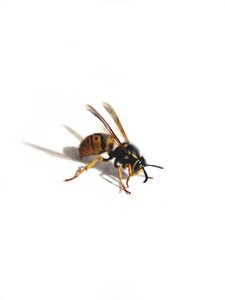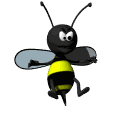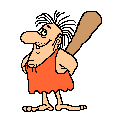Bee Buster
Process
Begin by learning a few terms (click on the link or
use a dictionary):
entomology
wasp
hornet
yellow jacket
(Psst! If you encounter any other word you need defined, click here
and enter it.)
Now, follow these steps to complete the tasks. Note the extra resources available under "Resources, Resources..." (shown below) that you may want to examine as you go through the steps, and remember to have fun!
1. Well, since the first step in solving any problem is to identify the problem itself, let's find out exactly what bee we are dealing with. Go to Bee and Wasp Identification and review the drawings of 8 types of bees/wasps. Select the 'paper wasps' link and review the short summary.
2. 'A picture paints a thousand words,' and will make your school display and letter to the maintenance department more interesting and informative. Print out the Paper wasp coloring page - and color it to match what our bees look like. You can find a picture to use as your guide by clicking on AltaVista search for paper wasp photos (you don't need to go through all the pages, just a few should do). Also check here for a couple of good pictures that you may find helpful. You may also draw more bee pictures (or capture/print them online) for your display if you'd like (you'll get a bonus point if you do!), but first finish the coloring page task. Another image that can be printed and then colored (which compares a paper wasp and a hornet or yellow jacket) can be found here.

3. Since we don't know a lot about the wasp family of bees, we'd better learn a little about them. Go to the Paper Wasp Data Collection Sheet, print out a copy, and follow the instructions to collect the information you need.
4. So, it seems that bees, even wasps, do serve a number of useful purposes. But what happens when, like at our school, they invade or infest the areas that we live and play? Take a peek at interesting 'infestations' (and don't miss the swell pictures of different types of bees at the bottom) to see some examples of infestations and how trained experts handle them. Make some notes on a piece of paper (for use later with your school display and letter) on what you should (and shouldn't) do to deal with bee infestations. You can find other helpful information at the following sites:
University of Kentucky Entomology



5. Time for a break! Here's one way you could choose to handle problem bees but I think you'll see why it wouldn't work too well. Click on swatter to play. Position your swatter and left-click to swat with sound (speakers on?). See what happens if you ignore some of them for awhile. You must manually close the window when you have figured out why this method would not be the best and are ready to go on.
Let's see, you've learned some terms, now have a picture (or pictures) of our type of bees, have collected data about their living habits, anatomy (body parts), things they do (good and bad), how to avoid getting stung, and what to do if you are stung. It's time to pull it all together for your letter to the maintenance department and your bulletin board presentation to the rest of the school.
6. Your teacher will provide you with the desired format for, and assistance with, your letter to the maintenance department. You should prepare however, by writing a draft of the body of the letter on a piece of paper. You should include the following 4 topics in your letter body: 1) identify the name of our bees, 2) a description of their nests, 3) other details about the wasps that you feel are important to know, and 4) instructions on how to safely treat and remove the bees and their nests.
7. For the school bulletin board presentation, your teacher will divide the class into groups/partners. You will share what you've learned and brainstorm with your teacher and other group members/partners what should be included under the two main categories of 'interesting facts and details about the bees', and 'safety tips and first aid procedures'. Your teacher will assist with display elements and ideas including how and where to incorporate the pictures that you came up with in your activities.

Resources, Resources...
Here are more links to sources of infomation that you may want to consider. Read the short description and decide if it would be beneficial to investigate it for your display or letter.
LA County - paper wasp nest straight on picture
Family Vespidae - wasps, hornets, yellow jackets, oh my! What's the difference?
Bee Games and Activities - Be a Kid/SueBee.com
More Bee Games - at Honey.com
Wasp Nest - since it has a covering over the cells, it was probably made by hornet-type wasps, but it's a dandy!
Bee Control Northwest - short summary and closeup pictures (click on each for a larger image).
Bugs of the Month - yellow jackets versus paper wasps discussion and sketch..
University of Nebraska - Lincoln - good overall information source with a few pictures too; more pictures here.
Geocities - pictures of Austrailian versions of the paperwasp (mostly black/red) and their nests; see more here.
University of Oklahoma Police Department - general discussion and first aid instructions (see the link toward the bottom).
JungleWalk.com - pictures, video, and audio of wasps (track them down through the menu choices on the left).
Wasp Identification Chart - solitary wasp versus social wasp characteristics.
CirusDigitalImaging - 5 good color pictures of our paperwasps (site was 'temporarily down' at last check so it may not be available).
Florida Dept. of Agriculture - yellowjackets and hornets
